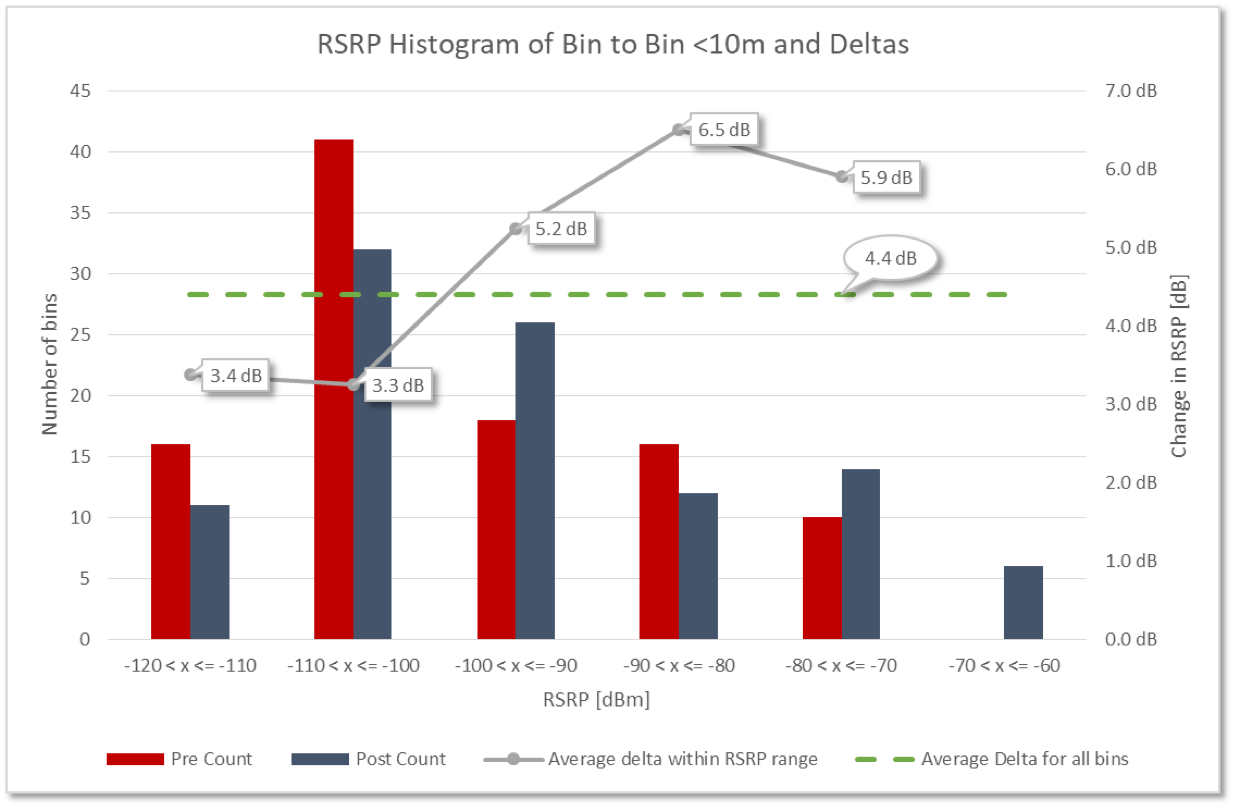Ultra-wide-band antenna improves Coverage, speed and load-balancing
In a field test in southeastern United States, CellMax’s newly released Ultra Wide Band antenna helped a carrier increase the coverage and speed of its 2.5 GHz band network and shift traffic away from its congested 800 and 1900 bands.
When a U.S. telecom company wanted to extend 2.5 GHz coverage and increase the load on this network to relieve congestion on its 800 and 1900 bands, it swapped one of its existing antennas with a CellMax 6520/E2-10 quad port, Ultra Wide Band antenna.
Detailed drive testing was done for both pre- and post-configurations. The Drive Tests were compared on a GPS bin-to-bin comparison, with one bin per location. This minimized the risk of collecting a disproportionate amount of data in one location (when stopped at a red traffic light, for example) or due to differences in drive routes.

Average improvement for all bins: +4.4 dB. Bins with Previously weak RSRP e.g. -100 dBm
The mobile drive data showed an average RSRP improvement within the test sector of +4.4 dB, exceeding the antenna’s advertised spec advantage of 3 dB by 1.4 dB. But that’s not the whole story.
“Evaluating the number of data bins with a range of a signal strength window can tell a story as to how a network change has impacted the cell edge,” explains Greg Paine, Technical Support Manager NA for CellMax. “We saw a clear shift in the RSRP distribution to higher signal levels after the CellMax antenna was installed – fewer bins for low RSRP and more bins for higher RSRP levels.
“Bins that previously had weak RSRP, like -110 dBm, improved by +3.4 dB – roughly the difference in gain of the pre antenna versus the CellMax model,” he continues. “Since CellMax has a slightly wider VBW and nullfill, it also provided a roughly +6 dB improvement for the bins that had RSRP of more than -100 dBm before the swap.”
The tests also showed an average CQI improvement of +1.21. At the same time, CINR improved by 4.07 dB. The CINR and CQI enhancements led to the use of higher modulation rates (DL 64 QAM +18%, UL 64 QAM +22%) improving network efficiency (b/s/Hz) by 38%.
“This allows the carrier to add more subscribers and/or sell more data, thereby increasing revenues without degrading the subscriber’s quality experience,” Greg says.

Changing the antenna for the 2.5 GHz LTE system to CellMax has a significant impact on the load balancing. Capacity is freed up on 800 and 1900 MHz and moved to the improved 2500 MHz band. This improves the customer experience because low-band spectrum is made available for the users really needing the extra propagation / coverage. Plus, more users are now able to use the vast spectrum on 2.5 GHz.
The increased performance can be seen in the changed subscriber behavior. “Connections, volume and throughput all increased significantly with the CellMax antenna,” he adds. “The average throughput increased by 37% even though volume increased 38%. There is no doubt that a great deal of untapped capacity exists on the 2.5 GHz carrier, but usually these two KPI’s manifest as inverses of one another.
“Raw drops increased by a nominal 6% on the 2.5 GHz carrier, but with the traffic increases the drop percentage has actually decreased,” Greg explains. “Looking at the KPI’s from the other 800 and 1900 bands, there were significant reductions in load.”
PCS in particular shows a 22% decrease in DL MBs and 32% in UL MBs.
“It’s also important to note that while average CQI decreased on the 800 and 1900 bands that’s actually a positive sign,” he points out. “It means that a higher percentage of users of these lower frequencies were farther from the site because of the extended 2.5 GHz band.”
Quick facts
- Verified by scanner drive test data, the CellMax antenna exceeded its advertised spec advantage of 3 dB by 1.4 dB.
- The link budget advantage of the CellMax antenna manifested itself in >35% increases in UL and DL MB volume and Average Throughput.
- Peak DL Throughout increased by 56%, exceeding 50 Mbps.
- Average Connection requests increased by 23% while Average Connected Users increased by 24%.
- A reduction in load on the 800 (-10%) and 1900 (-22%) MHz carriers of the trial sector was realized after the installation of the CellMax antenna.
- CINR and CQI enhancements led to the use of higher modulation rates on all carriers within the sector (DL 64 QAM +19%, UL 64 QAM +22%), improving network efficiency.
Customer cases
Real-world success stories
Contact
We’d love to hear from you!
Feel free to call us or send us a message.